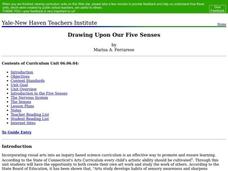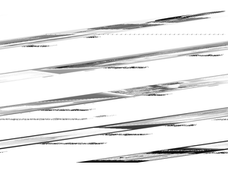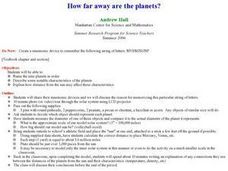Curated OER
Constructing a Periodic Table of Elements
Students create a periodic table of elements. For this chemistry lesson, students work together to build all of the different elements into a complete mini periodic table. They identify similarity and difference of the elements.
Curated OER
Turkeys in the Cell--The Meiosis Square Dance
Students identify synapsis as the key event in meiosis. They explain how synapsis leads to the formation of haploid gametes. Exploration of the differences between the processes of mitosis and meiosis occur. In accordance, explanations...
Curated OER
Exam Review: Chemistry Calculations
In this chemistry calculations review worksheet, students solve 33 review problems about titrations, precipitates, pressure and volume of gases, combustion reactions, heat of combustion, molar concentrations and molecular formulas.
Curated OER
Insect Monitoring
Students practice the scientific method in the classroom, either in preparation or as a substitution for real-world field experience. They examine a simulated biodiversity research situation, using a "mini-plot" or
sampling square...
Curated OER
Drawing Upon Our Five Senses
Students observe and create artistic representations, technological images, and scientific diagrams. They explore the five senses, the structure and function of the corresponding organs, and how the senses are connected to the human brain.
Curated OER
Drawing Upon Our Five Senses
Fifth graders identify the parts and functions of the body's five senses. In this biology lesson, 5th graders create a replica of the nervous system highlighting its parts. They create a scrapbook containing information on the senses...
Curated OER
The Circle of Life
Fourth graders examine how the different organisms living in an ecosystem affect one another. In groups, they research a specific ecosystem and present their findings to the class based on the type of organisms found in it. To end the...
Curated OER
Memory and Learning
Learners identify parts of the brain and what each part does. In this brain anatomy lesson, students participate in activities that focus on the job of each part of the brain co connect the task to the brain section. Learners make a...
Curated OER
The Tell-Tale Plume
Students examine hydrothermal vents. In this ocean lesson, students identify changes in physical and chemical properties of sea water caused by hydrothermal vents.
Curated OER
The Busy Brain
Students explore biology by completing a human body worksheet. In this human brain lesson, students identify the different anatomy within the brain and the functions those pieces form. Students read an article about signals in the brain...
Curated OER
Memory Game Art Project
Students create a memory game featuring the Arctic and, more particularly, the Arctic hare. They examine a few pictures on a website embedded in this plan in order to get an idea of the Arctic landscape and the activities of the Arctic...
Curated OER
How Far Away Are the Planets?
Students name nine planets in order, describe some notable characteristics of the planets, explain how distance from the sun may affect these characteristics, and create solar system models.
Curated OER
Wilderness Survival: A Field Practicum
Young scholars are provided with hands-on-field testing of authentic applications from principles pertaining to: Psychology A. Develop a positive, can-do attitude with a high degree of self-reliance that is transferable to human...
Curated OER
Wilderness Survival: A Field Practicum
Learners use hands-on field-testing of authentic application from principles pertaining to: Psychology- A. Develop a positive, can-do attitude with a high degree of self-reliance that is transferable to human interactions outside of the...
Curated OER
This Week's Weather
For this weather worksheet, learners fill out a weather map each day of the week and give the lows, the highs, the warm fronts and the cold fronts. They answer six questions from their weather map work.
Curated OER
Magnetic Fields and Bermuda Triangles
Students map magnetic fields of a magnet using a compass and predict where fields cancel each other to create 'Bermuda Triangles'. In this magnetism lesson, students use a compass to map the magnetic field of a magnet. They explain how...
Curated OER
Chemical Equations and Stoichiometry
In this chemical equations learning exercise, students write ten combustion equations given a hydrocarbon compound. They write the equations and balance each.
Curated OER
Flip Camera Lesson: Louisiana Animal Adaptations
Students research and present information about Louisiana animal adaptations. In this animal adaptation and video camera lesson, students choose an animal from a teacher prepared list. They use the Internet to find five adaptations which...
Curated OER
Lesson Ten: Your World Without Oil
Students participate in the World Without Oil game as they examine the effects of a prolonged oil shortage. In this oil shortage lesson, students play the online game, World Without Oil, before making an audio clip based on the...
Curated OER
Elementary Circuits
In this electrical circuits worksheet, students answer 12 questions about basic circuits including identifying parts of a circuit, answering questions about shorted circuits and determining if voltage would exist at certain test points...
Curated OER
Brain Power
Students study the brain and how it performs the memory function. In this brain power lesson students complete a memory activity.
Curated OER
Dangerous Earth
Students view a Dangerous Earth video and research a historic or recent earthquake. In this earthquake lesson students create a piece of are to portray the experience of their particular earthquake.
Curated OER
Teaching Neuro-anatomy Through Schematic Diagrams
Students develop a deeper understanding of the brain. In this neuro-anatomyl lesson plan, students will use simple diagrams to understand the brain and will progress to more complex diagrams as they gain understanding.
Curated OER
Case Study Two: Shark Dissection
Students read an article on sharks prior to beginning a dissection lab. As part of the lab, students identify differences between the shark anatomy and human anatomy and hypothesize why those differences exist.

























